GIS-Analysis for Active Tectonics Assessment of Wadi Al-Arish, Egypt
Abstract
1. Introduction
2. Study Area
3. Data and Methods
3.1. Stream Length-Gradient Index (SL)
3.2. Asymmetric Factor Index (Af)
3.3. Hypsometric Integral Index (Hi)
3.4. Drainage Basin Shape Index (Bs)
3.5. Valley Floor Width to Valley Height Ratio Index (Vf)
3.6. Mountain Front-Sinuosity Index (Smf)
4. Results and Discussion
4.1. Morphotectonic Indices
4.1.1. Stream Length-Gradient Index (SL)
4.1.2. Asymmetric Factor Index (Af)
4.1.3. Hypsometric Integral Index (Hi)
4.1.4. Drainage Basin Shape Index (Bs)
4.1.5. Valley Floor Width to Valley Height Ratio Index (Vf)
4.1.6. Mountain Front-Sinuosity Index (Smf)
4.2. Relative Tectonic Activity Levels Discussion
5. Conclusions
Supplementary Materials
Author Contributions
Funding
Acknowledgments
Conflicts of Interest
References
- Yildirim, C. Relative Tectonic Activity Assessment of the Tuz Gölü Fault Zone Central Anatolia, Turkey. Tectonophysics 2014, 630, 183–192. [Google Scholar] [CrossRef]
- Takarada, S.; Bandibas, J.C. Volcanic Hazards Information and Assessment Systems. In Forecasting and Planning for Volcanic Hazards, Risks, and Disasters; Elsevier: Amsterdam, The Netherlands, 2021; Volume 2, pp. 565–584. [Google Scholar] [CrossRef]
- Khalifa, A.; Bashir, B.; Alsalman, A.; Bachir, H. Morphometric-Hydro Characterization of the Coastal Line between El-Qussier and Marsa-Alam, Egypt: Preliminary Flood Risk Signatures. Appl. Sci. 2022, 12, 6264. [Google Scholar] [CrossRef]
- Görüm, T. Tectonic, Topographic and Rock-Type Influences on Large Landslides at the Northern Margin of the Anatolian Plateau. Landslides 2019, 16, 333–346. [Google Scholar] [CrossRef]
- Khalifa, A.; Çakir, Z.; Owen, L.A.; Kaya, Ş. Morphotectonic Analysis of the East Anatolian Fault, Turkey. Turk. J. Earth Sci. 2018, 27, 110–126. [Google Scholar] [CrossRef]
- El Hamdouni, R.; Irigaray, C.; Fernández, T.; Chacón, J.; Keller, E.A. Assessment of Relative Active Tectonics, Southwest Border of the Sierra Nevada (Southern Spain). Geomorphology 2008, 96, 150–173. [Google Scholar] [CrossRef]
- Mahmood, S.A.; Gloaguen, R. Appraisal of Active Tectonics in Hindu Kush: Insights from DEM Derived Geomorphic Indices and Drainage Analysis. Geosci. Front. 2012, 3, 407–428. [Google Scholar] [CrossRef]
- Abdelazim, M.; Samir, A.; El-nader, I.A.; Badawy, A.; Hussein, H.; Castelltort, S.; Whittaker, A.; Vergés, J.; Holbrook, J.; Schumm, S.A. Seismicity and Focal Mechanisms of Earthquakes in Egypt from 2004 to 2011. NRIAG J. Astron. Geophys. 1999, 305, 287–306. [Google Scholar] [CrossRef]
- Khalifa, A.; Bashir, B.; Alsalman, A.; Öğretmen, N. Morpho-Tectonic Assessment of the Abu-Dabbab Area, Eastern Desert, Egypt: Insights from Remote Sensing and Geospatial Analysis. ISPRS Int. J. Geo-Inf. 2021, 10, 784. [Google Scholar] [CrossRef]
- Sboras, S.; Lazos, I.; Mouzakiotis, E.; Karastathis, V.; Pavlides, S.; Chatzipetros, A. Fault Modelling, Seismic Sequence Evolution and Stress Transfer Scenarios for the July 20, 2017 (M W 6.6) Kos–Gökova Gulf Earthquake, SE Aegean. Acta Geophys. 2020, 68, 1245–1261. [Google Scholar] [CrossRef]
- Roselli, P.; Marzocchi, W.; Mariucci, M.T.; Montone, P. Earthquake Focal Mechanism Forecasting in Italy for PSHA Purposes. Geophys. J. Int. 2018, 212, 491–508. [Google Scholar] [CrossRef]
- Yang, J.; Xu, C.; Wen, Y.; Xu, G. Complex Coseismic and Postseismic Faulting During the 2021 Northern Thessaly (Greece) Earthquake Sequence Illuminated by InSAR Observations. Geophys. Res. Lett. 2022, 49, e2022GL098545. [Google Scholar] [CrossRef]
- Masoud, A.A.; Koike, K. Morphotectonics Inferred from the Analysis of Topographic Lineaments Auto-Detected from DEMs: Application and Validation for the Sinai Peninsula, Egypt. Tectonophysics 2011, 510, 291–308. [Google Scholar] [CrossRef]
- Badawy, A.; Mohamed, A.M.S.; Abu-Ali, N. Seismological and GPS constaints on Sanai sub-plate motion along the Suez rift. Stud. Geophys. Geod. 2008, 52, 397–412. [Google Scholar] [CrossRef]
- Moawad, M.B. Analysis of the Flash Flood Occurred on 18 January 2010 in Wadi El Arish, Egypt (a Case Study). Geomat. Nat. Hazards Risk 2013, 4, 254–274. [Google Scholar] [CrossRef]
- Kader, H.A. GIS Based Morphometric Analysis of Wadi El-Arish Watershed Sinai, Egypt-Using ASTER (DEM) Data. Int. J. Sci. Eng. Res. 2020, 11, 682–694. [Google Scholar]
- Elbarbary, S.; Araffa, S.A.S.; El-Shahat, A.; Abdel Zaher, M.; Khedher, K.M. Delineation of Water Potentiality Areas at Wadi El-Arish, Sinai, Egypt, Using Hydrological and Geophysical Techniques. J. Afr. Earth Sci. 2021, 174, 104056. [Google Scholar] [CrossRef]
- Corporation, C.; Conoco, G.P. General Petroleum Corporation. Geological Map of Egypt, Scale 1:500,000; Gebel Hamata: Cairo, Egypt, 1987. [Google Scholar]
- Abdelsalam, M.G.; Stern, R.J. Sutures and Shear Zones in the Arabian-Nubian Shield. J. Afr. Earth Sci. 1996, 23, 289–310. [Google Scholar] [CrossRef]
- Moustafa, A.R. Structural Setting and Tectonic Evolution of North Sinai Folds, Egypt. Geol. Soc. Spec. Publ. 2010, 341, 37–63. [Google Scholar] [CrossRef]
- Abdelfadil, K.M.; Obeid, M.A.; Azer, M.K.; Asimow, P.D. Late Neoproterozoic Adakitic Lavas in the Arabian-Nubian Shield, Sinai Peninsula, Egypt. J. Asian Earth Sci. 2018, 158, 301–323. [Google Scholar] [CrossRef]
- Ben-Menahem, A. Earthquake Catalogue for the Middle East (92 B.C.-1980 A.D.). Boll. Geofis. Orica Ed. Appl. 1979, 21, 245–310. [Google Scholar]
- Poirier, J.P.; Taher, M.A. Historical Seismicity in the near and Middle East, North Africa, and Spain from Arabic Documents (VIIth-XVIIIth Century). Bull. Seismol. Soc. Am. 1980, 70, 2185–2201. [Google Scholar] [CrossRef]
- Maamoun, M.; Megahed, A.; Allam, A. Seismicity of Egypt. Bull. Helwan Inst. Astron. Geophys. 1984, 4, 109–160. [Google Scholar]
- Ambraseys, N.; Melville, C.R.A. The Seismicity of Egypt, Arabia and the Red Sea: A Historical Review; Cambridge University Press: Cambridge, UK, 1994. [Google Scholar]
- Kebeasy, R.M. Seismicity. In The Geology of Egypt; Routledge: Abingdon, UK, 1990; pp. 51–59. [Google Scholar] [CrossRef]
- Abu El Enean, K. A Study on the Seismotectonics of Egypt in Relation to the Mediterranean and Red Sea Tectonics. Ph.D. Thesis, Ain Shams University, Cairo, Egypt, 1997. [Google Scholar]
- Abdel-Rahman, K.; Al-Amri, A.M.; Abdel-Moneim, E. Seismicity of Sinai Peninsula, Egypt Kamal Abdel-Rahman. Arab. J. Geosci. 2015, 2, 103–118. [Google Scholar] [CrossRef]
- Joffe, S.; Garfunkel, Z. Plate Kinematics of the Circum Red Sea-a Re-Evaluation. Tectonophysics 1987, 141, 5–22. [Google Scholar] [CrossRef]
- Le Pichon, X.; Francheteau, J. A Plate-Tectonic Analysis of the Red Sea-Gulf of Aden Area. Tectonophysics 1978, 46, 369–388. [Google Scholar] [CrossRef]
- McKenzie, D.P. Plate Tectonics of the Mediterranean Region. Nature 1970, 226, 239–243. [Google Scholar] [CrossRef]
- McKenzie, D. Active Tectonics of the Mediterranean Region. Geophys. J. R. Astron. Soc. 1972, 30, 109–185. [Google Scholar] [CrossRef]
- Badawy, A. Present-Day Seismicity, Stress Field and Crustal Deformation of Egypt. J. Seismol. 2005, 9, 267–276. [Google Scholar] [CrossRef]
- Badawy, A.; Horváth, F. Seismicity of the Sinai Subplate Region: Kinematic Implications. J. Geodyn. 1999, 27, 451–468. [Google Scholar] [CrossRef]
- Mahmoud, S.; Reilinger, R.; McClusky, S.; Vernant, P.; Tealeb, A. GPS Evidence for Northward Motion of the Sinai Block: Implications for E. Mediterranean Tectonics. Earth Planet. Sci. Lett. 2005, 238, 217–224. [Google Scholar] [CrossRef]
- Cochran, J.R. Northern Red Sea: Nucleation of an Oceanic Spreading Center within a Continental Rift. Geochem. Geophys. Geosystems 2005, 6, 3. [Google Scholar] [CrossRef]
- Steckler, M.S.; Berthelot, F.; Lyberis, N.; Le Pichon, X. Subsidence in the Gulf of Suez: Implications for Rifting and Plate Kinematics. Tectonophysics 1988, 153, 249–270. [Google Scholar] [CrossRef]
- McClay, K.; Khalil, S. Extensional Hard Linkages, Eastern Gulf of Suez, Egypt. Geology 1998, 26, 563. [Google Scholar] [CrossRef]
- Bartov, Y.; Steinitz, G.; Eyal, M.; Eyal, Y. Sinistral Movement along the Gulf of Aqaba—Its Age and Relation to the Opening of the Red Sea. Nature 1980, 285, 220–222. [Google Scholar] [CrossRef]
- Patton, T.L.; Moustafa, A.R.; Nelson, R.A.; Abdine, S.A. Tectonic Evolution and Structural Setting of the Suez Rift. In Interior Rift Basins; American Association of Petroleum Geologists: Tulsa, OK, USA, 1994. [Google Scholar] [CrossRef]
- Garfunkel, Z.; Zak, I.; Freund, R. Active Faulting in the Dead Sea Rift. Tectonophysics 1981, 80, 1–26. [Google Scholar] [CrossRef]
- Bosworth, W.; Taviani, M. Late Quaternary Reorientation of Stress Field and Extension Direction in the Southern Gulf of Suez, Egypt: Evidence from Uplifted Coral Terraces, Mesoscopic Fault Arrays, and Borehole Breakouts. Tectonics 1996, 15, 791–802. [Google Scholar] [CrossRef]
- Abd El Samie, S.G.; Sadek, M.A. Groundwater Recharge and Flow in the Lower Cretaceous Nubian Sandstone Aquifer in the Sinai Peninsula, Using Isotopic Techniques and Hydrochemistry. Hydrogeol. J. 2001, 9, 378–389. [Google Scholar] [CrossRef]
- Corchete, V.; Chourak, M.; Hussein, H.M. Shear Wave Velocity Structure of the Sinai Peninsula from Rayleigh Wave Analysis. Surv. Geophys. 2007, 28, 299–324. [Google Scholar] [CrossRef]
- El-Ghazawi, M.M. Hydrogeological Studies in Northeast Sinai, Egypt. Ph.D. Thesis, Mansoura University, Mansoura, Egypt, 1989. [Google Scholar]
- Letouzey, J.; Tremolieres, P. Paleo-stress Field around the Mediterranean since the Mesozoic from microtectonics. Comparison with plate tectonic data. In Rock Mechanics; Springer: Vienna, Austria, 1980; pp. 173–192. [Google Scholar] [CrossRef]
- Eyal, Y.; Reches, Z. Tectonic Analysis of the Dead Sea Rift Region since the Late-Cretaceous Based on Mesostructures. Tectonics 1983, 2, 167–185. [Google Scholar] [CrossRef]
- Mahmoud, S.M. Seismicity and GPS-Derived Crustal Deformation in Egypt. J. Geodyn. 2003, 35, 333–352. [Google Scholar] [CrossRef]
- El-Fiky, G.S. GPS-Derived Velocity and Crustal Strain Field in The. Bull. Earthq. Res. Inst. Univ. Tokyo 2005, 80, 73–86. [Google Scholar]
- Horton, R.E. Erosional Development of Streams and Their Drainage Basins: Hydrophysical Approach to Quantitative Morphology. Bull. Geol. Soc. Am. 1945, 56, 275–370. [Google Scholar] [CrossRef]
- Bhattarai, I.; Gani, N.D.; Xue, L. Geomorphological Responses of Rivers to Active Tectonics along the Siwalik Hills, Midwestern Nepalese Himalaya. J. Mt. Sci. 2021, 18, 1268–1294. [Google Scholar] [CrossRef]
- Hack, J.T. Stream-Profile Analysis and Stream-Gradient Index. J. Res. Us Geol. Surv. 1973, 1, 421–429. [Google Scholar]
- Keller, E.A.; Pinter, N. Active Tectonics: Earthquakes, Uplift and Landscape, 2nd ed.; Prentice Hall: Upper Saddle River, NJ, USA, 2002. [Google Scholar]
- Bhat, M.A.; Dar, T.; Bali, B.S. Morphotectonic Analysis of Aripal Basin in the North-Western Himalayas (India): An Evaluation of Tectonics Derived from Geomorphic Indices. Quat. Int. 2020, 568, 103–115. [Google Scholar] [CrossRef]
- Ezati, M.; Gholami, E. Neotectonics of the Central Kopeh Dagh Drainage Basins, NE Iran. Arab. J. Geosci. 2022, 15, 992. [Google Scholar] [CrossRef]
- Baruah, M.P.; Bezbaruah, D.; Goswami, T.K. Active Tectonics Deduced from Geomorphic Indices and Its Implication on Economic Development of Water Resources in South-Eastern Part of Mikir Massif, Assam, India. Geol. Ecol. Landsc. 2020, 6, 99–112. [Google Scholar] [CrossRef]
- Cardoso, M.; da Silveira, A.S.; de Vargas, M.R.; de Oliveira, J.M.M.T.; Barbosa, D.V.E.; de Oliveira, L.F.B.; Fredere, A.C.; Lôndero, V. Geomorphic Expression of Shear Zones in Southern Brazilian and Uruguayan Shields. Geomorphology 2021, 382, 107678. [Google Scholar] [CrossRef]
- Strahler, A. Dynamic Basis of Geomorphology. Geol. Soc. Am. Bull. 1952, 63, 923–938. [Google Scholar] [CrossRef]
- Owen, L.A. 5.2 Tectonic Geomorphology: A Perspective. In Treatise on Geomorphology; Elsevier: Amsterdam, The Netherlands, 2013; Volume 148, pp. 3–12. [Google Scholar] [CrossRef]
- Partabian, A.; Nourbakhsh, A.; Ameri, S. GIS-Based Evaluation of Geomorphic Response to Tectonic Activity in Makran Mountain Range, SE of Iran. Geosci. J. 2016, 20, 921–934. [Google Scholar] [CrossRef]
- Faghih, A.; Samani, B.; Kusky, T.; Khabazi, S.; Roshanak, R. Geomorphologic Assessment of Relative Tectonic Activity in the Maharlou Lake Basin, Zagros Mountains of Iran. Geol. J. 2012, 47, 30–40. [Google Scholar] [CrossRef]
- Khalifa, A.; Çakir, Z.; Owen, L.A.; Kaya. Evaluation of the Relative Tectonic Activity of the Adıyaman Fault within the Arabian-Anatolian Plate Boundary (Eastern Turkey). Geol. Acta 2019, 17, 1–17. [Google Scholar] [CrossRef]
- Bull, W.B.; McFadden, L.D. Tectonic Geomorphology North and South of the Garlock Fault, California. In Geomorphology in Arid Regions: A Proceedings Volume of the 8th Annual Geomorphology Symposium; Doehring, D.O., Ed.; State University of New York: Binghamton, NY, USA, 1977; pp. 559–589. [Google Scholar]
- Keller, E.A.; Pinter, N. Active Tectonics:Earthquakes, Uplift, and Landscape; Prentice Hall: Upper Saddle River, NJ, USA, 2022. [Google Scholar]
- Ramírez-Herrera, M. Geomorphic Assessment of Active Tectonics in the Acambay Graben, Mexican Volcanic Belt. Earth Surf. Process. Landf. 1998, 23, 317–332. [Google Scholar] [CrossRef]
- Silva, P.G.; Goy, J.L.; Zazo, C.; Bardají, T. Faulth-Generated Mountain Fronts in Southeast Spain: Geomorphologic Assessment of Tectonic and Seismic Activity. Geomorphology 2003, 50, 203–225. [Google Scholar] [CrossRef]
- Rockwell, T.K.; Keller, E.A.; Johnson Donald, L. Tectonic Geomorphology of Alluvial Fans and Mountain Fronts near Ventura, California. In Tectonic Geomorphology; Morisawa, M., Hack, J.T., Eds.; Allen and Unwin Publishers: Boston, MA, USA, 1985; pp. 183–207. [Google Scholar]
- Elnobi, M.; Bashir, B.; Alsalman, A.; Bachir, H. Geospatial Analytics for Preliminarily Landscape Active Tectonic Assessment of the Wadi Araba Basin, Western Gulf of Suez, Egypt. Appl. Sci. 2022, 12, 12152. [Google Scholar] [CrossRef]
- Azor, A.; Keller, E.A.; Yeats, R.S. Geomorphic Indicators of Active Fold Growth: South Mountain-Oak Ridge Anticline, Ventura Basin, Southern California. Bull. Geol. Soc. Am. 2002, 114, 745–753. [Google Scholar] [CrossRef]
- Xue, L.; Gani, N.D.; Abdelsalam, M.G. Drainage Incision, Tectonic Uplift, Magmatic Activity, and Paleo-Environmental Changes in the Kenya Rift, East African Rift System: A Morpho-Tectonic Analysis. Geomorphology 2019, 345, 106839. [Google Scholar] [CrossRef]
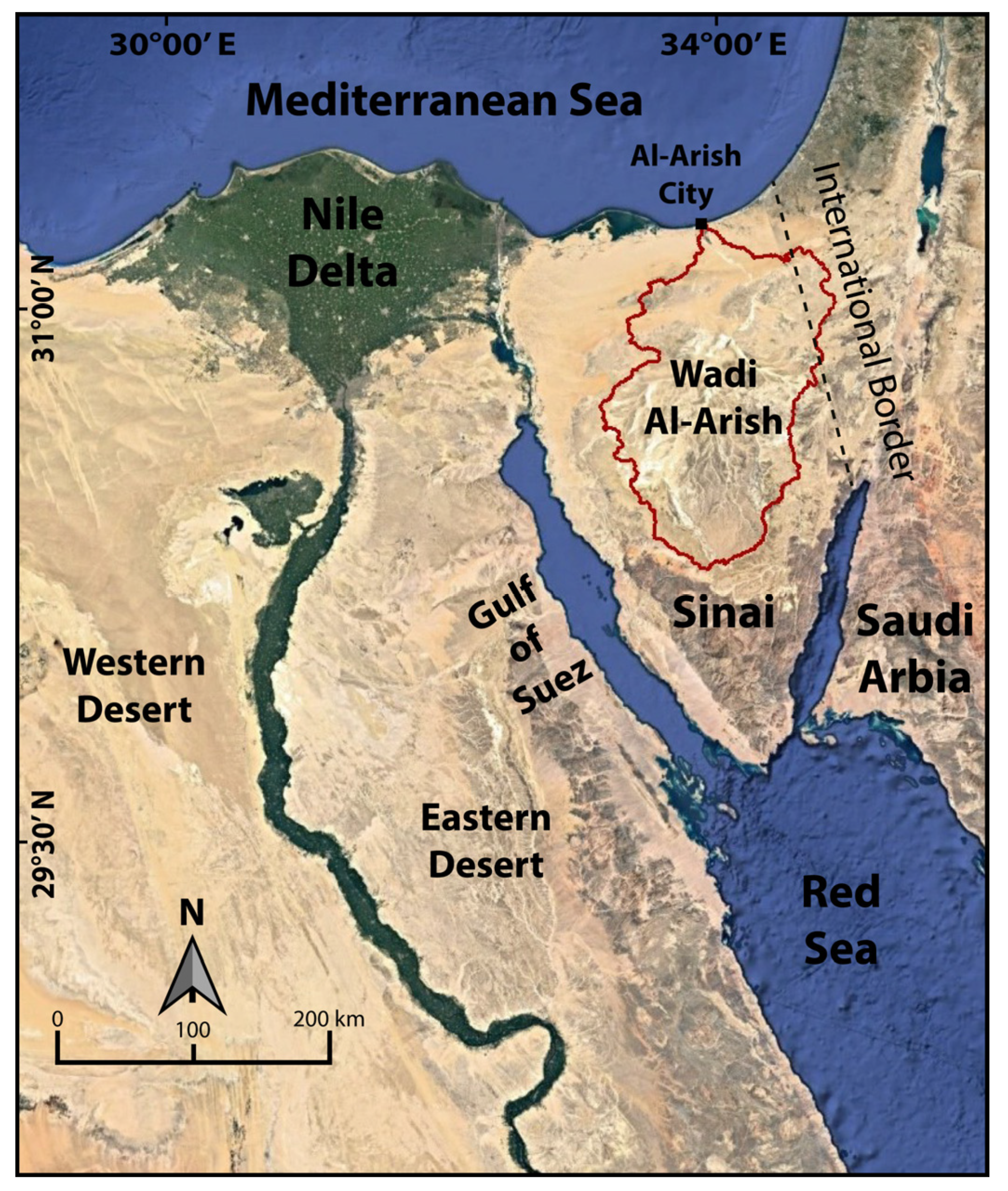
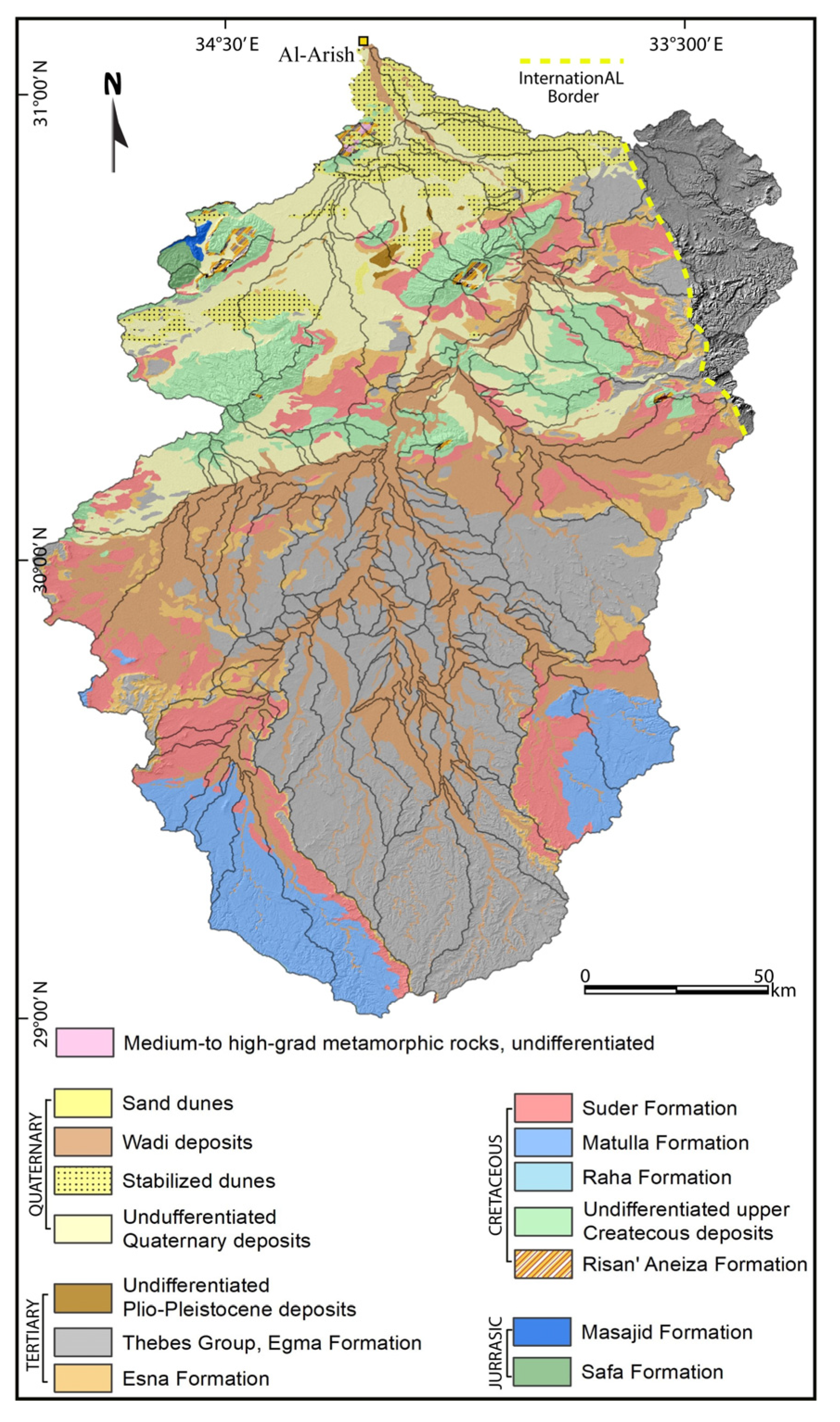
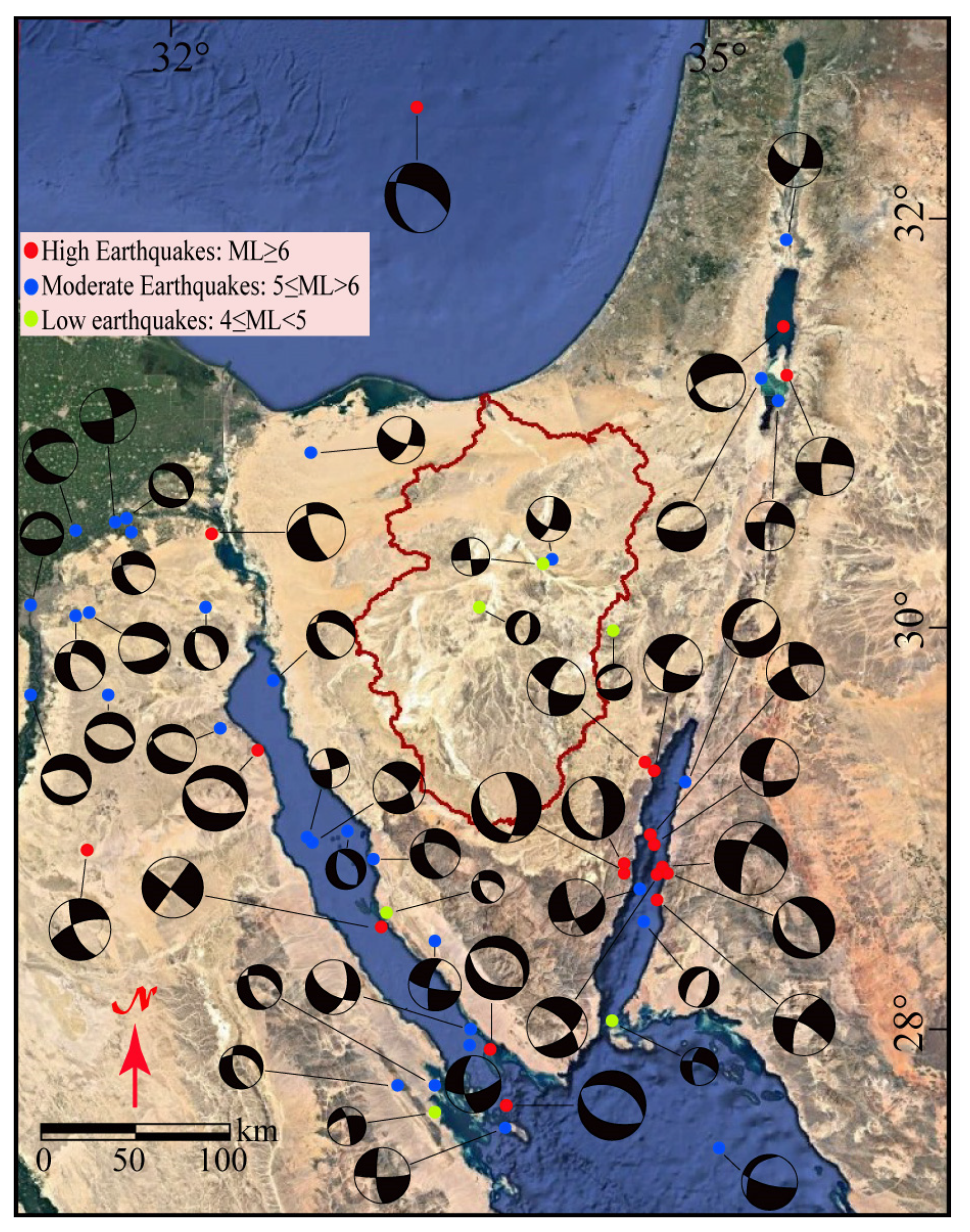

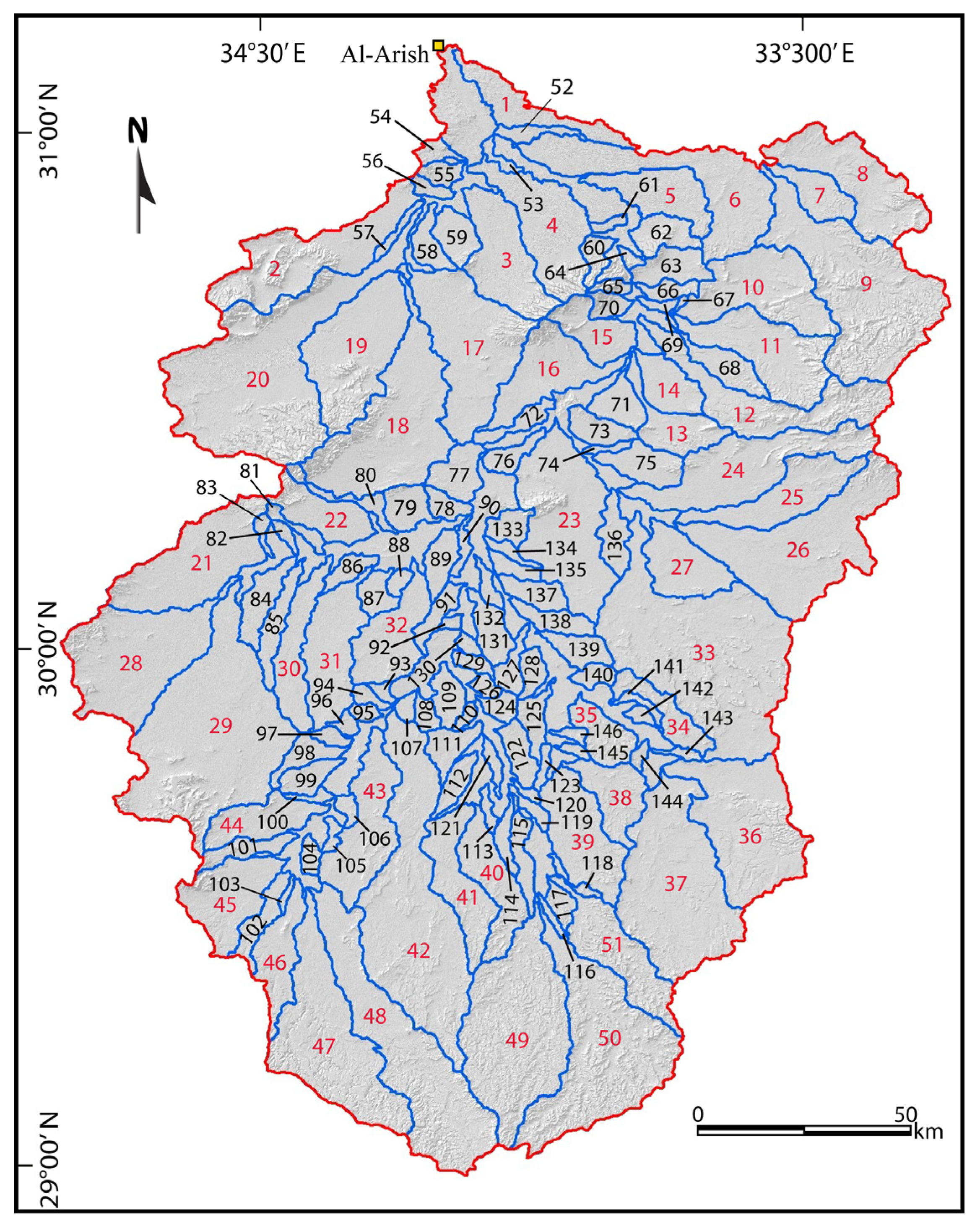
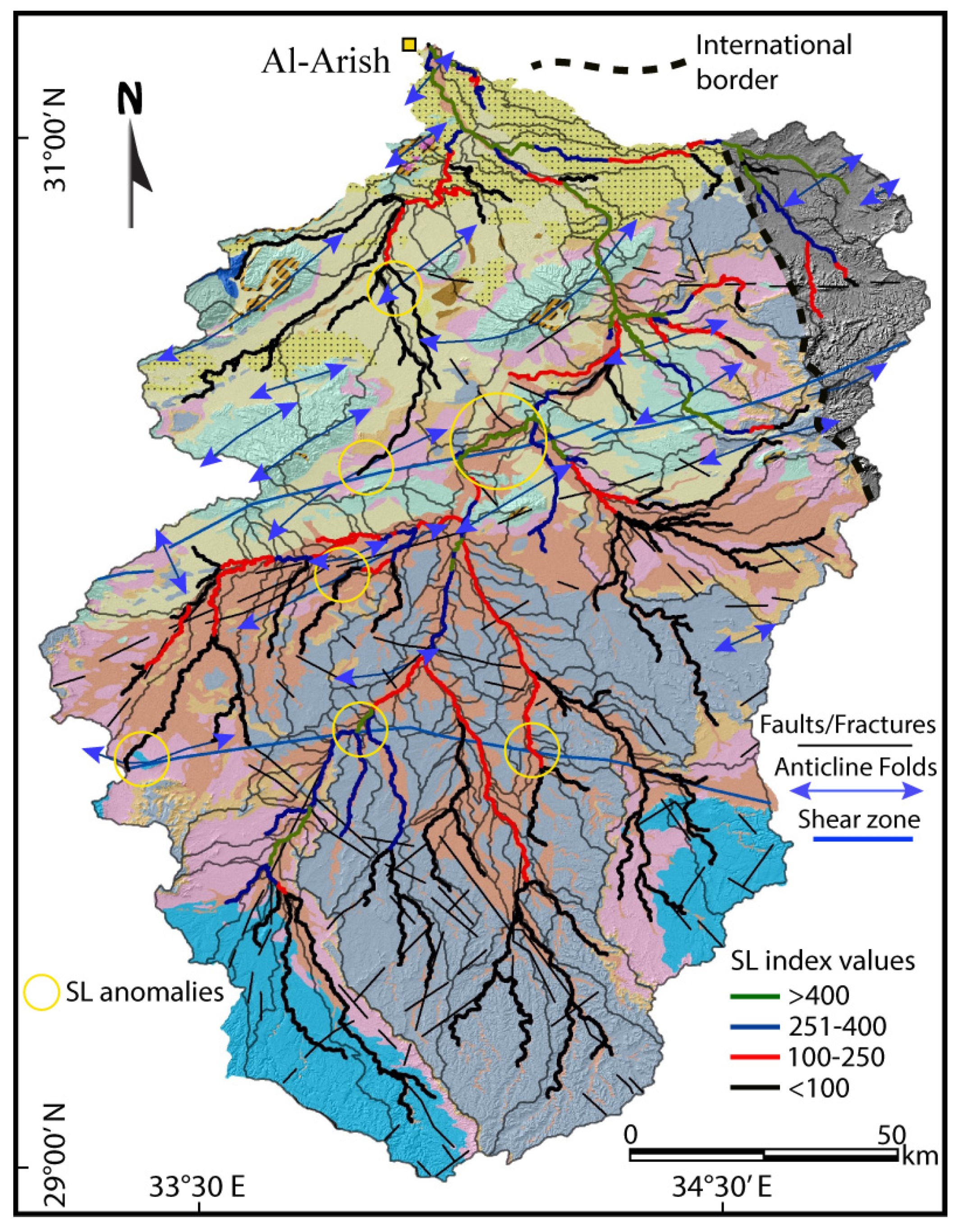
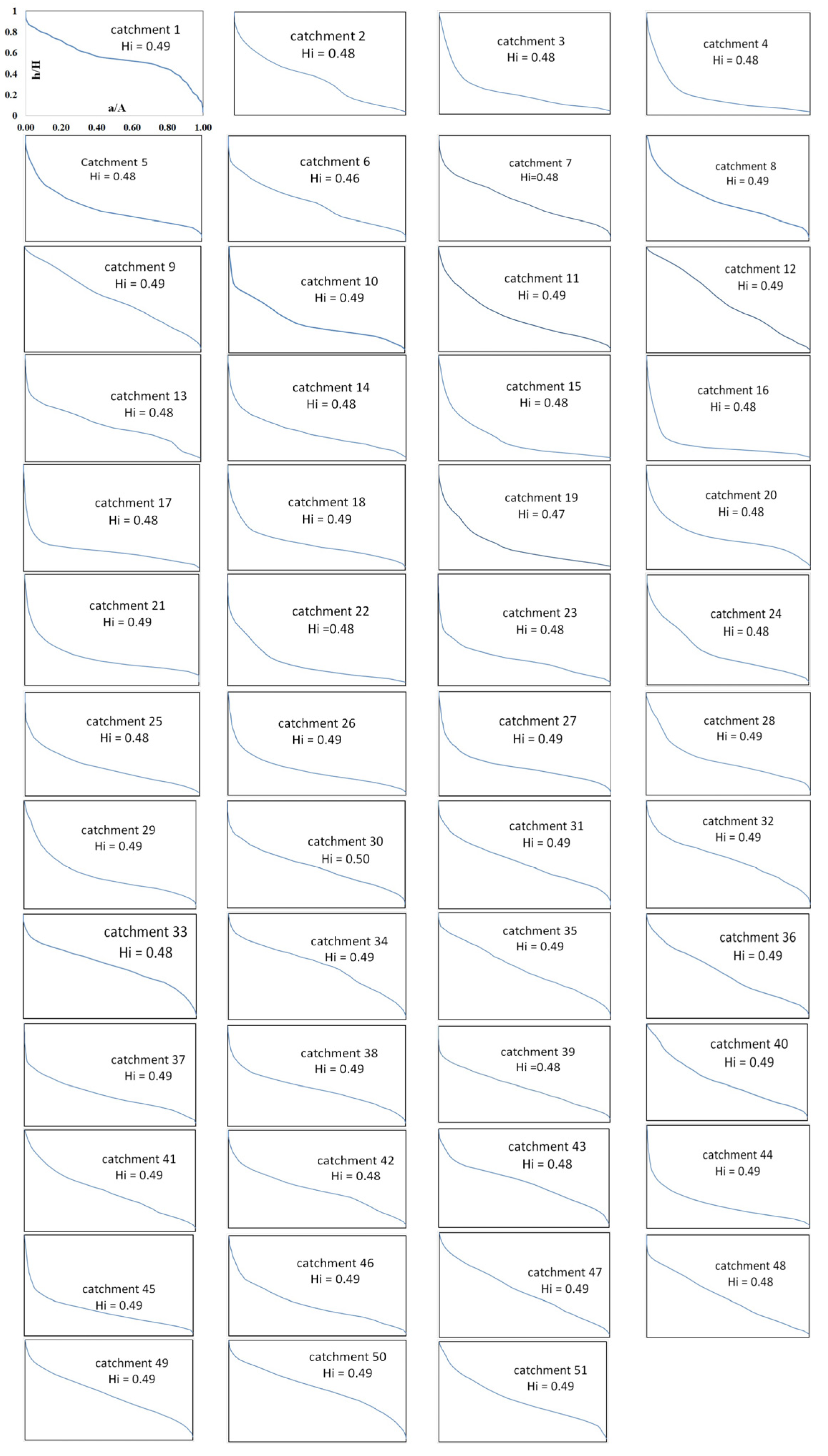


| Catch. | A/L | RTAL | Catch. | A/L | RTAL | Sub-C. | A/L | RTAL |
|---|---|---|---|---|---|---|---|---|
| 1 | 1.80 | 2 | 50 | 2.25 | 3 | 98 | 2.50 | 4 |
| 2 | 2.75 | 4 | 51 | 1.75 | RTAL | 99 | 3.00 | 4 |
| 3 | 2.50 | 4 | Sub-C. | A/L | 2 | 100 | 2.50 | 4 |
| 4 | 2.25 | 4 | 52 | 2.00 | 4 | 101 | 2.50 | 4 |
| 5 | 2.75 | 4 | 53 | 2.25 | 4 | 102 | 1.75 | 2 |
| 6 | 2.50 | 4 | 54 | 2.50 | 3 | 103 | 1.75 | 2 |
| 7 | 3.00 | 4 | 55 | 2.25 | 2 | 104 | 2.25 | 3 |
| 8 | 1.75 | 2 | 56 | 2.00 | 4 | 105 | 1.75 | 2 |
| 9 | 1.75 | 2 | 57 | 2.50 | 4 | 106 | 2.25 | 3 |
| 10 | 1.75 | 2 | 58 | 2.75 | 4 | 107 | 2.00 | 2 |
| 11 | 2.75 | 4 | 59 | 2.75 | 4 | 108 | 2.50 | 4 |
| 12 | 2.50 | 4 | 60 | 2.75 | 3 | 109 | 2.75 | 4 |
| 13 | 2.50 | 3 | 61 | 2.25 | 4 | 110 | 1.50 | 1 |
| 14 | 2.50 | 4 | 62 | 2.75 | 3 | 111 | 2.50 | 4 |
| 15 | 2.50 | 3 | 63 | 2.50 | 2 | 112 | 2.50 | 3 |
| 16 | 2.25 | 3 | 64 | 2.00 | 2 | 113 | 2.00 | 2 |
| 17 | 2.25 | 4 | 65 | 2.00 | 3 | 114 | 1.75 | 2 |
| 18 | 2.50 | 4 | 66 | 2.25 | 4 | 115 | 2.00 | 2 |
| 19 | 2.25 | 3 | 67 | 2.75 | 2 | 116 | 2.25 | 3 |
| 20 | 2.75 | 4 | 68 | 2.00 | 2 | 117 | 2.25 | 4 |
| 21 | 2.50 | 4 | 69 | 2.00 | 4 | 118 | 2.00 | 2 |
| 22 | 2.50 | 4 | 70 | 2.50 | 4 | 119 | 1.75 | 2 |
| 23 | 2.75 | 4 | 71 | 2.75 | 2 | 120 | 2.75 | 4 |
| 24 | 2.50 | 4 | 72 | 1.75 | 3 | 121 | 2.00 | 2 |
| 25 | 2.50 | 4 | 73 | 2.25 | 2 | 122 | 2.50 | 4 |
| 26 | 2.25 | 3 | 74 | 1.75 | 3 | 123 | 1.50 | 1 |
| 27 | 2.25 | 3 | 75 | 2.25 | 4 | 124 | 2.50 | 4 |
| 28 | 2.50 | 4 | 76 | 2.50 | 4 | 125 | 2.00 | 2 |
| 29 | 2.75 | 4 | 77 | 2.50 | 4 | 126 | 2.25 | 3 |
| 30 | 2.25 | 3 | 78 | 2.50 | 2 | 127 | 2.50 | 4 |
| 31 | 2.50 | 3 | 79 | 2.00 | 3 | 128 | 1.75 | 2 |
| 32 | 2.00 | 4 | 80 | 2.25 | 4 | 129 | 2.25 | 3 |
| 33 | 2.50 | 3 | 81 | 2.75 | 2 | 130 | 2.75 | 4 |
| 34 | 2.00 | 2 | 82 | 2.00 | 4 | 131 | 2.00 | 2 |
| 35 | 2.25 | 3 | 83 | 2.50 | 2 | 132 | 2.50 | 4 |
| 36 | 2.00 | 2 | 84 | 1.75 | 3 | 133 | 2.75 | 4 |
| 37 | 2.50 | 3 | 85 | 2.25 | 3 | 134 | 2.25 | 3 |
| 38 | 2.50 | 3 | 86 | 2.25 | 4 | 135 | 2.00 | 2 |
| 39 | 2.50 | 3 | 87 | 2.75 | 3 | 136 | 2.50 | 4 |
| 40 | 2.50 | 3 | 88 | 2.25 | 4 | 137 | 2.50 | 3 |
| 41 | 1.75 | 2 | 89 | 2.50 | 3 | 138 | 2.25 | 3 |
| 42 | 2.00 | 2 | 90 | 2.25 | 3 | 139 | 2.75 | 4 |
| 43 | 2.00 | 2 | 91 | 2.25 | 3 | 140 | 1.75 | 2 |
| 44 | 2.75 | 4 | 92 | 2.25 | 4 | 141 | 2.25 | 3 |
| 45 | 2.25 | 3 | 93 | 2.75 | 3 | 142 | 2.25 | 3 |
| 46 | 2.50 | 3 | 94 | 2.25 | 3 | 143 | 2.25 | 3 |
| 47 | 2.25 | 4 | 95 | 2.25 | 2 | 144 | 2.50 | 4 |
| 48 | 2.25 | 3 | 96 | 1.75 | 3 | 145 | 2.00 | 2 |
| 49 | 2.25 | 4 | 97 | 2.25 | 4 | 146 | 2.50 | 4 |
Disclaimer/Publisher’s Note: The statements, opinions and data contained in all publications are solely those of the individual author(s) and contributor(s) and not of MDPI and/or the editor(s). MDPI and/or the editor(s) disclaim responsibility for any injury to people or property resulting from any ideas, methods, instructions or products referred to in the content. |
© 2023 by the authors. Licensee MDPI, Basel, Switzerland. This article is an open access article distributed under the terms and conditions of the Creative Commons Attribution (CC BY) license (https://creativecommons.org/licenses/by/4.0/).
Share and Cite
Bashir, B.; Alsalman, A.; Bachir, H.; Elnobi, M. GIS-Analysis for Active Tectonics Assessment of Wadi Al-Arish, Egypt. Appl. Sci. 2023, 13, 2659. https://doi.org/10.3390/app13042659
Bashir B, Alsalman A, Bachir H, Elnobi M. GIS-Analysis for Active Tectonics Assessment of Wadi Al-Arish, Egypt. Applied Sciences. 2023; 13(4):2659. https://doi.org/10.3390/app13042659
Chicago/Turabian StyleBashir, Bashar, Abdullah Alsalman, Hussein Bachir, and Mahmoud Elnobi. 2023. "GIS-Analysis for Active Tectonics Assessment of Wadi Al-Arish, Egypt" Applied Sciences 13, no. 4: 2659. https://doi.org/10.3390/app13042659
APA StyleBashir, B., Alsalman, A., Bachir, H., & Elnobi, M. (2023). GIS-Analysis for Active Tectonics Assessment of Wadi Al-Arish, Egypt. Applied Sciences, 13(4), 2659. https://doi.org/10.3390/app13042659









